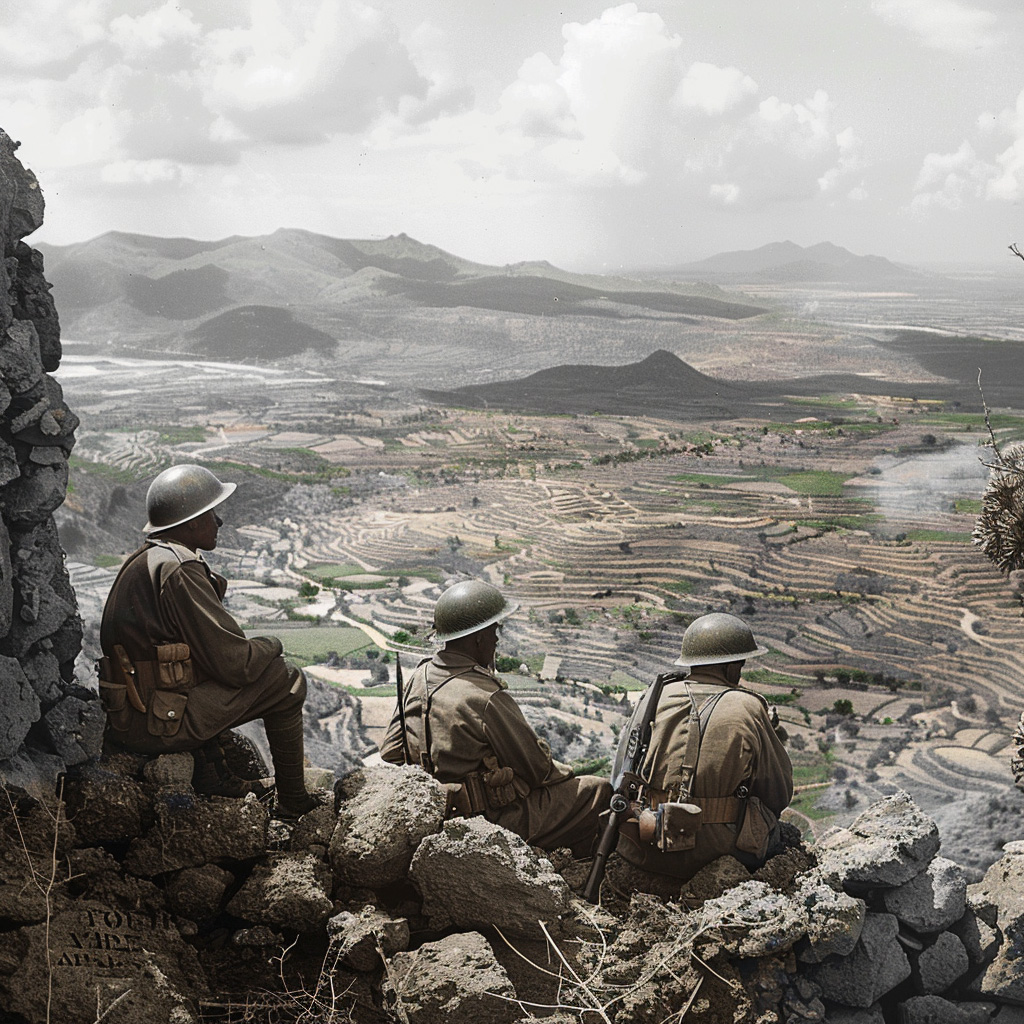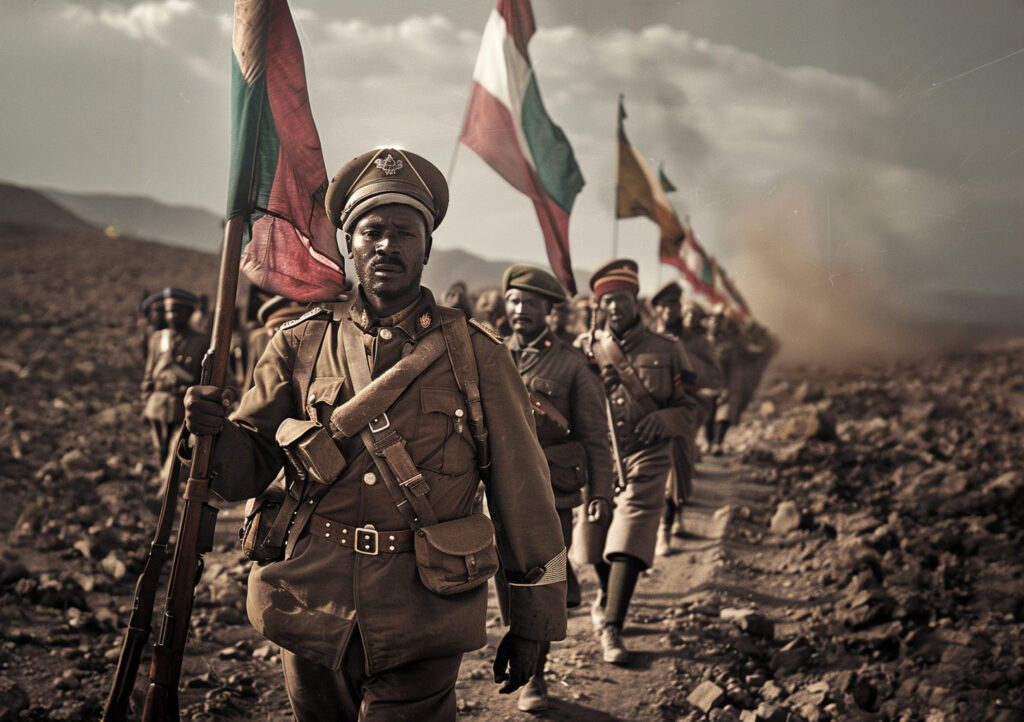The Second Italo-Ethiopian War (1935-1936) was a brutal conflict between Italy and Ethiopia, driven by imperial ambitions and resulting in significant regional and global impacts.
The Second Italo-Ethiopian War, fought between October 1935 and May 1936, was a crucial conflict in the interwar period that highlighted the aggressive expansionism of Fascist Italy under Benito Mussolini. This war saw Italy attempting to expand its colonial empire by invading Ethiopia, one of the few remaining independent African nations. The conflict not only resulted in a catastrophic defeat for Ethiopia but also exposed the weaknesses of the League of Nations and set the stage for further aggression leading up to World War II.
What were the reasons for the Second Italo-Ethiopian War (1935-1936)?
The roots of the Second Italo-Ethiopian War lay in Italy’s imperial ambitions and desire to restore national pride after its humiliating defeat at the Battle of Adwa in 1896, during the First Italo-Ethiopian War. Mussolini, aiming to build a New Roman Empire, saw the conquest of Ethiopia as essential to asserting Italy’s power and prestige on the global stage.
Economic factors also played a significant role. Italy, grappling with the effects of the Great Depression, sought to divert attention from domestic issues by engaging in foreign conquests. The promise of rich resources and new markets in Ethiopia offered a potential solution to Italy’s economic woes.
Diplomatic failures and international indifference further fueled the conflict. The 1928 Italo-Ethiopian Treaty of Friendship was undermined by Italy’s continued border provocations and the Wal Wal incident in December 1934, where clashes between Ethiopian and Italian forces provided Mussolini with a pretext for invasion. The League of Nations’ inability to enforce meaningful sanctions against Italy emboldened Mussolini, illustrating the organization’s ineffectiveness in curbing aggression and maintaining peace.

Who was involved in the Second Italo-Ethiopian War (1935-1936)?
The primary belligerents in the Second Italo-Ethiopian War were the Kingdom of Italy and the Ethiopian Empire. Italy, led by Prime Minister Benito Mussolini, sought to expand its African colonies by subjugating Ethiopia. Mussolini’s Fascist regime mobilized a modern, well-equipped military force, including advanced weaponry and chemical agents.
Ethiopia, under Emperor Haile Selassie I, faced the Italian invasion with a largely agrarian society and an ill-equipped army. Despite lacking modern weaponry and international support, the Ethiopians displayed remarkable resilience and determination in defending their homeland.
International actors played indirect roles. The League of Nations, despite Ethiopia’s membership, failed to provide effective assistance or enforce sanctions against Italy. Major powers such as the United Kingdom and France, wary of antagonizing Mussolini and concerned about their interests in Europe, chose a policy of appeasement, further isolating Ethiopia.
The involvement of these parties significantly impacted the war’s progression and outcome. Italy’s superior military capabilities and the use of brutal tactics, including chemical warfare, overwhelmed Ethiopian defenses. Meanwhile, Haile Selassie’s appeals to the international community underscored the geopolitical complexities of the interwar period and the limitations of collective security mechanisms.
The leaders of the Second Italo-Ethiopian War (1935-1936)
Key leaders in the Second Italo-Ethiopian War were Benito Mussolini and Emperor Haile Selassie I. Mussolini, Italy’s Fascist dictator, sought to consolidate his regime’s power and prestige through aggressive expansion. He orchestrated the invasion of Ethiopia, leveraging Italy’s military strength and propaganda to rally domestic support for his imperial ambitions.
Mussolini’s generals, notably Pietro Badoglio and Rodolfo Graziani, played crucial roles in the military campaign. Badoglio led the initial invasion, employing modern tactics and weaponry to swiftly advance into Ethiopian territory. Graziani, known for his ruthlessness, conducted operations in the southern front, using chemical weapons and brutal reprisals to suppress resistance.
Emperor Haile Selassie I emerged as a symbol of Ethiopian sovereignty and resistance. Ascending to the throne in 1930, he sought to modernize Ethiopia and strengthen its defenses. As the war unfolded, Selassie personally led his troops and attempted to galvanize international support against the Italian aggression. His passionate plea before the League of Nations in June 1936 highlighted the plight of his nation and the failure of international diplomacy, though it did little to alter the war’s outcome.
Post-war, Mussolini’s reputation as a leader was temporarily bolstered by the conquest, but the brutality of the campaign tarnished his legacy. Haile Selassie went into exile but returned to power in 1941 after Ethiopia’s liberation during World War II, continuing his efforts to modernize and unify Ethiopia until his deposition in 1974.
Was there a decisive moment?
The war’s decisive moment came on October 3, 1935, when Italian forces launched a full-scale invasion from Eritrea, breaching the Ethiopian frontier. This aggressive action, sanctioned by Mussolini, signified the point of no return, as diplomatic efforts to avert the conflict had failed. The League of Nations’ subsequent declaration of Italy as an aggressor state on October 7, 1935, and the imposition of sanctions, although symbolically important, were ineffective in halting the Italian advance. The lack of substantial international intervention emboldened Mussolini, ensuring the conflict would proceed to its brutal conclusion.
What were the major battles?
The Second Italo-Ethiopian War featured several key battles that determined the course of the conflict:
- Battle of Adwa (October 6-7, 1935): Early in the invasion, Italian forces sought to capture Adwa, a symbolically significant town from the First Italo-Ethiopian War. Led by General Emilio De Bono, the Italians overwhelmed Ethiopian defenses with superior firepower and aerial bombardment, securing a crucial early victory.
- Battle of Tembien (January 20 – February 24, 1936): This series of engagements saw Italian forces, commanded by Marshal Pietro Badoglio, push through the rugged Tembien region. The Ethiopians, under Ras Mulugeta, mounted fierce resistance but were ultimately outmatched by Italian artillery and air power. The battle demonstrated the Italians’ tactical superiority and their use of chemical weapons to devastating effect.
- Battle of Amba Aradam (February 10-19, 1936): Badoglio’s forces attacked the strategic mountain stronghold of Amba Aradam, held by Ras Mulugeta. Despite difficult terrain and determined Ethiopian resistance, the Italians utilized heavy artillery and poison gas, resulting in a decisive victory that opened the path to the Ethiopian heartland.
- Battle of Shire (February 29 – March 2, 1936): In this critical engagement, Badoglio’s troops decisively defeated Ethiopian forces led by Ras Imru. The use of mustard gas and overwhelming firepower enabled the Italians to capture key positions and inflict heavy casualties, further demoralizing Ethiopian forces.
- Battle of Maychew (March 31, 1936): This was the final major confrontation, where Emperor Haile Selassie personally led his troops against the Italians. Despite initial successes, the Ethiopians were eventually overwhelmed by Italian mechanized units and air superiority. The defeat at Maychew marked the collapse of organized Ethiopian resistance and paved the way for the Italian advance towards the capital.
These battles underscored the technological and tactical disparities between the Italian and Ethiopian forces. The Italians’ use of modern weaponry, combined with chemical warfare, proved decisive in overcoming Ethiopian defenses, leading to the eventual fall of Addis Ababa and the occupation of Ethiopia.
Was there a turning point?
The turning point of the war occurred at the Battle of Amba Aradam in February 1936. This battle showcased the effectiveness of Italian military tactics and their willingness to use chemical weapons to secure victory. The fall of Amba Aradam broke the backbone of Ethiopian resistance in the northern front, leading to a series of rapid Italian advances and subsequent defeats for the Ethiopian forces. This turning point marked the shift in momentum firmly in favor of the Italians, ensuring their eventual conquest of Ethiopia.

The consequences of the Second Italo-Ethiopian War (1935-1936)
The Second Italo-Ethiopian War had profound and far-reaching consequences. For Ethiopia, the war resulted in the loss of sovereignty and a brutal occupation marked by widespread atrocities and the suppression of local resistance. The use of chemical weapons and other war crimes committed by Italian forces left deep scars on the Ethiopian population.
Italy, while achieving its imperial ambitions, faced international condemnation and strained relations with other powers. The League of Nations’ failure to effectively intervene undermined its credibility and emboldened other aggressive states, contributing to the erosion of international peace efforts and the onset of World War II.
Globally, the conflict highlighted the weaknesses of collective security mechanisms and the dangers of appeasement. It also fostered anti-colonial sentiments across Africa and the world, inspiring future movements for independence and self-determination.
–
The Second Italo-Ethiopian War remains a stark example of the consequences of unchecked aggression and the failures of international diplomacy. The conflict reshaped Ethiopia and Italy, had significant geopolitical repercussions, and set a troubling precedent for the lead-up to World War II. The lessons from this war underscore the importance of effective international cooperation and the defense of sovereign rights against imperialistic ambitions.
Back to the Wars section